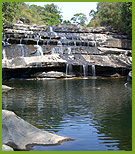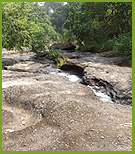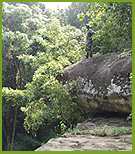Phou Khao Khouay
 |
Interesting alternatives to mainstream tourism are currently developed in several parts of Lao PDR. Community – based nature and culture tourism in some of the country’s twenty National Protected Areas ( “NPA”, also know as “NBCA” or “National Biodiversity Conservation Areas” ) is aiming to give visitors a glimpse of the magnificent heritage of the Lao people –without compromising the integrity and rights of the people or the interests of nature conservation. To be sustainable, this goal requires the full participation of the local people in the development process and the creation of new, but acceptable sources of income. Only then, the wonderful but often poor people in rural Laos will have hope for a decent future, nature conservation efforts of the Government can be more successfully implemented, and tourists will experience a memorable time in this country. Tourists from all over the world are welcome to visit ‘Laos’ Protected Areas, but are asked to understand and cooperate with the local people in order to avoid any negative impact on their culture – and nature as well – to the most possible extent.
Phou Khao Khouay – National Protected Area
|
Phou Khao Khouay, literally translated as the “mountain of the buffalo horn”, is a mountain range nearly 40 km north – east of Vientiane, as the crow files. The area covers about 2000 square km, with its highest peaks reaching up to 1671 m. Phou Khao Khouay is drained by three larger rivers(NamMang, Nam Leuk and Nam Gnong –“ nam ” = “water” or “river” ) and count - less smaller tributaries, partly flowing through deep and narrow gorges, and ultimately emptying into the nearby Mekong river. To the north-west,the park is bordering on the Nam Ngum reservoir, South - East Asia’s largest man -made lake. Two smaller reservoirs,“ Ang Nam Leuk ” ( opened for power generation in 2003 ) and “ Ang Nam Mang 3” , are located in the central northern portion of the park, and in the west, respectively. The latter is due to be ready by 2005, and is currently a construction site of little tourism value for the time being.
 |
Diverse vegetation types such as dry evergreen dipterocarp, mixed deciduous or mostly mononspecific coniferous forests, the latter in association with extensive fire - climax grasslands, are found on either rough mountain slopes, steep sandstone cliffs, hilly terrain, or relative flat uplands. They offer a wide range of habitats for large mammals of high conservation value, such as Asia Elephant, tiger, Sun Bear, Asiatic Black Bear, White – cheeked Gibbon and Payre’s Langur and more, as well as for smaller mammals like bats, numerous reptiles, amphibians and birds. Of special interest is one of the last remnants in Laos of the once common, but now almost extinct Green Peafowl, surviving only in a small, confined special protection zone at the south – western border. The park is also home to a large number of butterflies and countless other insect species.[More detailed information on wildlife is given in the excellent “ 1999 Status Report on Wildlife in Lao PDR” available at the IUCN office, Fa Ngum Road, Vientiane or in some book stores]. Recent floral surveys have been rare and a comprehensive study on the highly diverse plant species found in Phou Khao Khouay still needs to be tackled.
Most of the area is covered by typical brown soils ( orthic acrisol and lithosols ), which are poor in organic matter. Some richer soils occur in valleys and gorges, with an obvious change of vegetation. Layered sandstone is visible throughout the park. Visitors may be puzzled by the origin of circular and often deep holes, regularly found in the rocky riverbeds all over. These “ whirlpools” were ‘’drilled ‘’ over a long period of time by revolving stones, brought into motion by strong water currents during the rainy seasons.
Relatively few people live within the park boundaries ( actually only 3 villages on the western side ). On the other hand, the park is surrounded by numerous, sometimes large villages – more than 70 alone in the relatively narrow buffer zone of 5 km radius from the park’s borders, putting immense pressure on flora and fauna of the Protected Area ( some local markets can tell the story ) To the north of the park, the picturesque, narrow but long Long Xan valley is home to people of four different ethnic groups : Hmong, Yao, Khmu and so – called ‘ Lao Loum ‘. Here the traveler can discover the traditional way of life and the specific handicraft of the friendly people living in this comparatively remote place.
How to get ‘ Phou Khao Khouay ‘ and what is awaiting you here
|
A The central/eastern part
 |
The park here is relatively easy to access even with an ordinary car or by motorbike via National Road No. 13 ( South ). Turn left about Km 90, short before entering Thabok. Sign boards all along the way will guide you. The unpaved road traversing the park has been upgraded for the Nam Leuk dam construction and is fairly well maintained, even the rainy season ( no guarantee ). It finally leads to the northern part of the park where the new Nam Leuk reservoir is located ( please follow the instructions ‘’ dam ‘’ on the sign board ), or further on where the road branches off ( direction ‘’ powerhouse ‘’ , which can be visited too ). Heading to the most northern steep slopes overlooking the Long Xan valley and the more than 2000 m high mountain range further to the north you’ll reach some small village and Long Xan itself ). The dam site has yet to recover from the scars of construction work and may not be too attractive.
Thabok can be reached easily by public transport on rout to the south. e.g. Paksan or Savannakhet... Several “buses” ( lorry! ) and ‘’ bush – taxis ‘’ ( songthaew ) are departing daily from Thabok, a small town along Rd. 13, destined for the Long Xan valley . Fixed schedules are not available ( please inquire in Thabok ). There are also ‘’ songthews ‘’ once or twice a day shuttling between ‘’ Talat Tad Luang ‘’ in Vientiane ( usually here in the morning hours about 9 o’ clock ) and Ban Thabok/Ban Hatkhai – and also to Ban Na. If you take a bus to Ban Na, just drop out at Ban Phabath ( with its famous stupa ) and walk 1.5 km.
Ban Na is accessible by any kind transport. On has to turn left at Ban Phabath ( highway 13, km 80 ). There are two main reasons why only strictly organized trips to Ban Na are encouraged : a ) the presence of elephants poses a potential danger for visitors and b ) to avoid any negative impact on the wellbeing of the animals. Well versed village guides will lead you. The sighting of elephants cannot be guaranteed, but chances are good. The disputable attraction of Ban Na, a long awaited elephant observation tower, is currently under construction and may be ready for visitors by March 2005. Ban Na can also be a starting point for wonderful treks into the nearby jungle, with destinations like Nam Hi, Tad Fa, or Tad Lung.
Ban Hatkhai is easily accessible via Thabok (Rd. 13 south), though it may not so easy to get transport from Thabok to the village, if you don’t have your own vehicle. You may even convince a boat owner in Thabok to bring you there. It is therefore advisable to consult a tour operator in Vientiane who can organize group tours to this village. A diverse program for exciting nature trips (don’t forget your swim suit) is offered from the tour guide association in the village. Tours will start with a boat trip along the Nam Mang river, after which several treks good and beautiful evergreen forest can be booked going to Tad Xay, Pha Luang or Houey Ki Ling, respectively.
Tad Xay/ Pha Xay may be the most beautiful ‘’ twin waterfall in Phou Khao Khouay. The Xay stream cascading (Tad Xay ) over several steps into a paradise – like valley, just to plunge down another steep 40m cliff ( Pha Xay) about 800m downstream into a breathtaking gorge filled with dense forest. Here pure nature awaits you. Beware of climbing the rocks, it can be hazardous, especially when wet and slippery! [Nearly 20 km from the highway via Ban Hatkhai only].
Tad Leuk is already a popular destination for weekend visitors from Vientiane, both Lao and foreigner, and offers some infrastructure (see below, ‘facilities’ but is by no means crowed. In fact, most of the time you will find yourself alone here. The Waterfall changes its water levels, depending on the season. This place is easy to reach, ideal for a refreshing swim in the river and camping, and is good as starting point for extensive hikes through lush nature. Has ‘Nature Trail ‘ and Visitor Center. [About 21 km from the highway via Ban Houay Leuk; currently a good car and ‘skilled’ driver are needed, since the last 4 km may prove to be really bupy due to erosion on few short stretches]
Pha Xet, is found about 50 km from the highway and between the road turning left to the dam site of Ang Nam Leuk and the road branching off to the powerhouse. It is steep cliff of about 40 – 50 meters and offers wonderful views on the mountains of Pho Khao Khouay. The place is difficult to locate. Watch out for larger open sandstone plateau to the left of the road. During October, the flat rocks are studded with orchids and other, often tiny flowers, and thus being a heaven for photographers.
Ang Nam Leuk ( Nam Leuk Reservoir, ca. 56 km from highway ) is offering wonderful views of this man made lake nestled in pristine forest ( it is best to go to northern most tip of the ‘elbow’, where the ‘’ water – intake ‘’ is ). Boat trips on the lake and into its long and narrow side arms ( tributaries ) are good for bird watching. No regular tours are currently available, though.
B.The western part
Tad Phou Khao Kouay in the west can be reached vai Road No. 10 (according to some maps No.15!) near Ban Napheng. However, this part of the park is temporarily off limits for tourism due to the construction of a reservoir designed for irrigation of the dry rice fields in the nearby lowlands (Ang Nam Mang 3). Here, the landscape is dominated by pine forest and grasslands. During the dry months the air is filled with the bewitching scent if pines Wonderful! One has to wait until the scares are healed.
C. Facilities inside the park
A Visitor Center with an informative exhibition- a first in Laos – on the park’s flora and fauna in both Lao and English language at Tad Leuk is connected with a Nature Trail of about 1.5 km. There is no guesthouse inside the park yet. The nearest guesthouses are in Thabok, or in Ban Khonwat in the ( Long Xan valley) but camping is permitted at Tad Leuk (tents and respective equipment can be rented here!). Ban Na and Ban HatKhai are prepared for home stay accommodation. A small restaurant at Tad Leuk can serve basic Lao food and cool but (due to lack of electricity unfortunately , and hopefully only for the time being) no “ ice cold…”drinks. Please bear with it! The very friendly caretaker family will be happy to welcome you and to give any assistance needed. They do not speak English. In the villages we’re trying right now to overcome this little obstacle with volunteering teachers from overseas.
Guided trekking tours can be booked at Ban Na and Ban HatKhai .The villagers welcome visitors for a “day in the village” to discover authentic rural life in Laos. Ban Na is also ideal for its handicraft (sticky rice baskets-you want to learn how to do it?). For canoeing, rafting (only seasonal), biking, fishing and the like, please contact your tour operator in Vientiane. Combined tours to/from Vang Vieng via the Long Xan valley and the Nam Ngum reservoir may also be an attractive option.
D. Further Information
More detailed information on some destinations is available with brochures like this one for Ban Na, Ban HatKhai , Tad Leuk ,Tad Xay/Pha Xay. And try our web-site: www.trekkingcentrallaos.com , For further help , please do not hesitate to contact the LNTA Tourist Information Center, Lane Xang Avenue,in Vientiane or ask your tour operator.
Additional attractions around Phou Khao Khouay worth visiting |
Are at the western side
• The huge Nam Ngum Reservoir, the largest man-made lake in South-East Asia, directly connected with the park on its north-western border and a tourist destination in its own right;
• Ban Sivilay or “Nong Nok” (“Bird Lake”),a community-manged bird sanctuary a few kilometers to the west of the park with hundreds of whistling ducks and egrets roosting here;
• The privately run Zoological Garden at Ban Geun (Muang Thoulakhom),also in the west.
And at the eastern/central side
• Wat Phabat/Wat Phonsanh with a huge “footprint” of Buddha ,colorful murals and a nice view of the Mekong .Both temples and their gardens are really beautiful but unfortunately not well maintained;
• Boat trips from Thabok or Ban HatKhai on the Nam Mang river to Tad Mang, gorgeous rapids block the trip further up-sream.
Trips to all sites can be organized according to your personal wishes by your tour operator in Vientiane. Some are easy to reach by car or even with public transport, while other destinations need some extra effort to get to.
Community- Based Tourism Development at Phou Khao Kouay NPA |
The National Tourism Administration of Lao PDR, the PKK Management and a DED- Adviser work closely together to develop community-based tourism sites in and around this National Park. This goal can only be achieved by involving the local people in all decision making and implementation phases and with full transparency for the “ Stakeholders’” of all steps during the project progress .In village meetings and workshops the entire community gets informed and is asked to share their opinion about the project activities . The villagers finally decide what’s to be done.
Training are conducted for volunteering or elected villagers to become guide, to serve the visitor by preparing food, offer their home for village accommodation, or to manage the finances. The aim is that the villagers will get the maximum benefit from thr tourism in their village and not outsiders. The people are also given the opportunity to reject certain or even all activities if they are considered damaging to their community.
The project currently works in two villages in the buffer zone of the park: Ban Na near the Phabath is a village of 110 families , which suffers serious problems from elephants, which ransack the fields of the farmers since feew years. In an attempt to help the Lao Government’s efforts to alleviate this ‘classical’ human-wildlife conflict, the project tries to generate alternative incomes for the villagers for which tourism could be an ideal tool. The threat to the village is turned into an attraction here, offering several tours into’ elephant country’ .From the other village, Ban HatKhai rewarding tours into the mountains with astounding views and the most beautiful waterfalls of the park can be arranged. In return it is hoped that the villagers will understand the importance nature conservation issues , the very basis for sustainable “eco” – tourism in a National Protected Area and their new small enterprise. With booking a tour to Ban Na and Ban HatKhai , tourist (you!)directly support this endeavor.May this project succeed and serve as a model for other areas!
The Phou Khao Khouay Tourism Development Project is a joint venture of the National Tourism Administration of Lao PDR and the German Development Service (DED)
|

